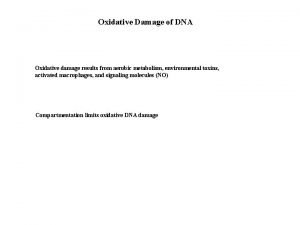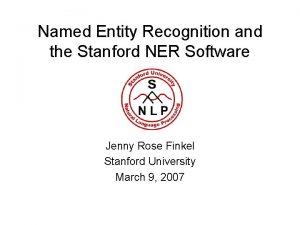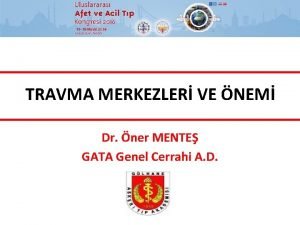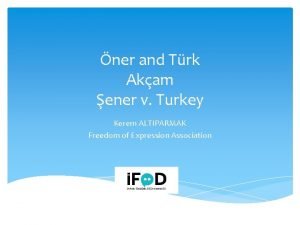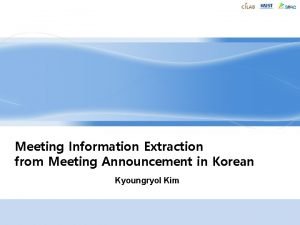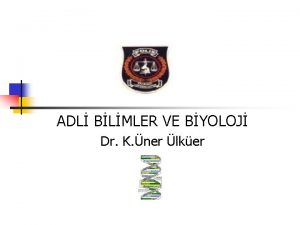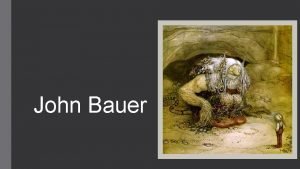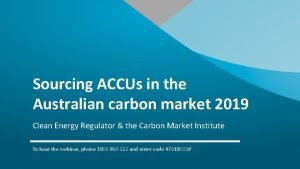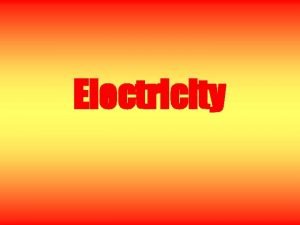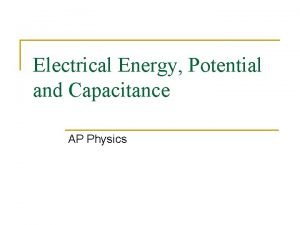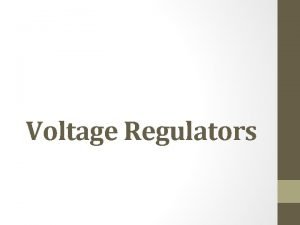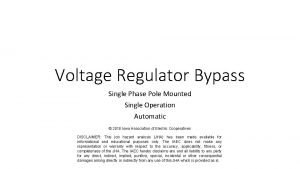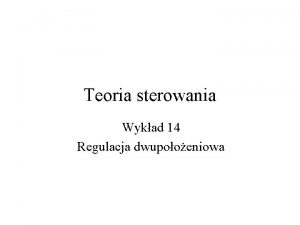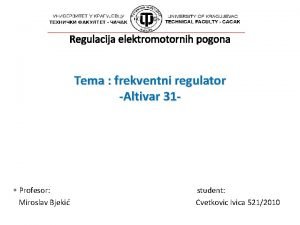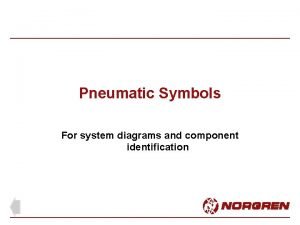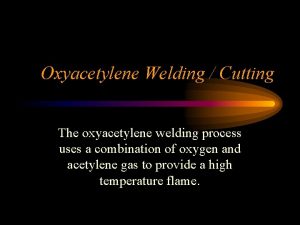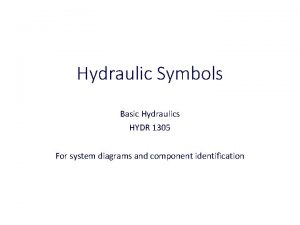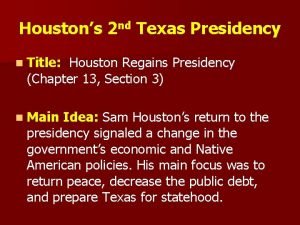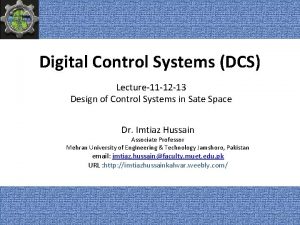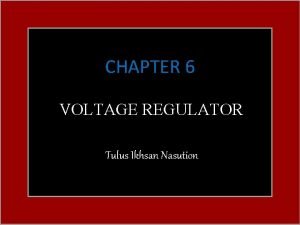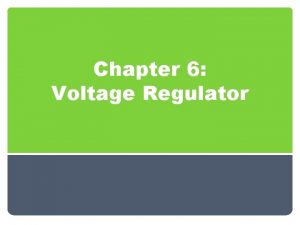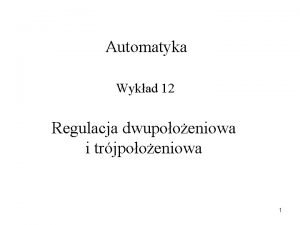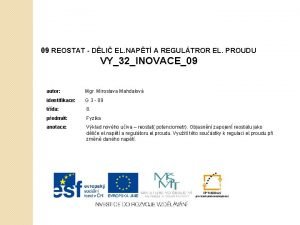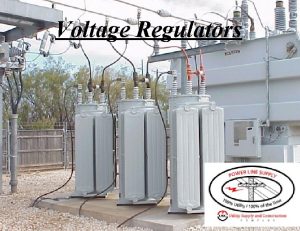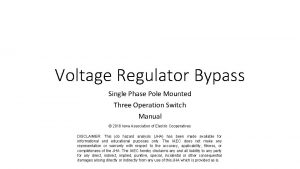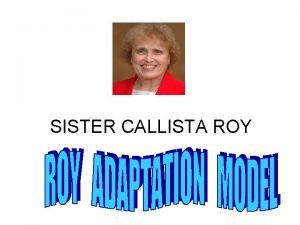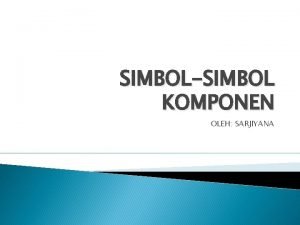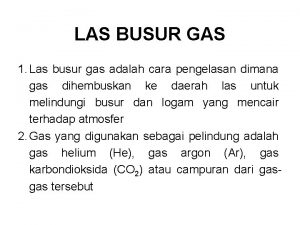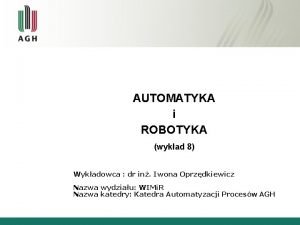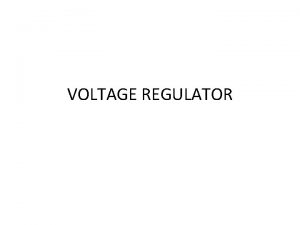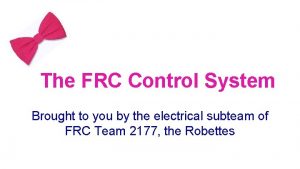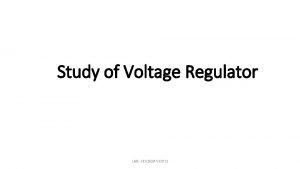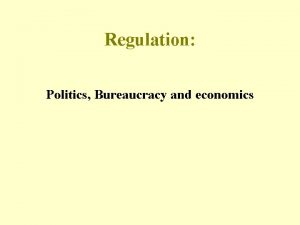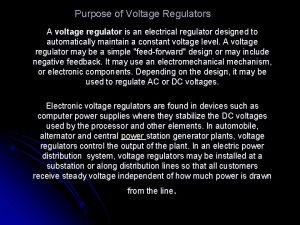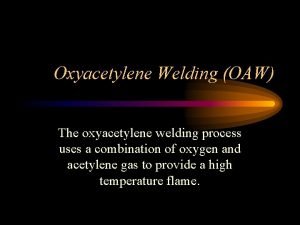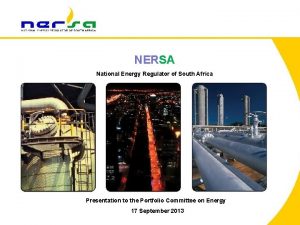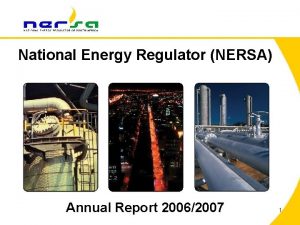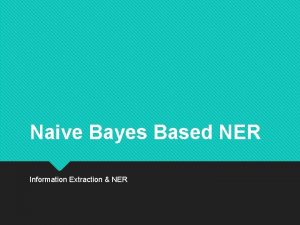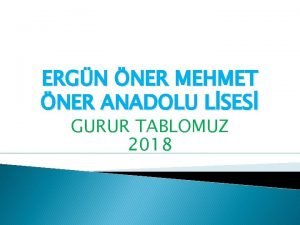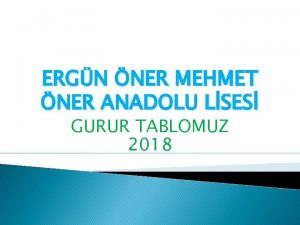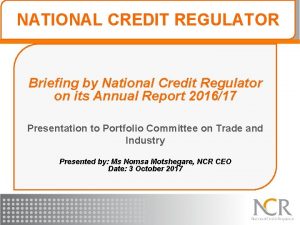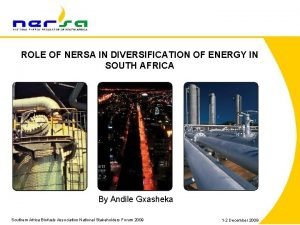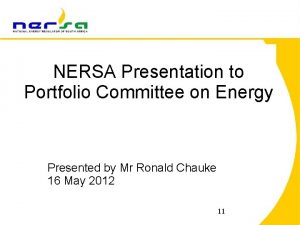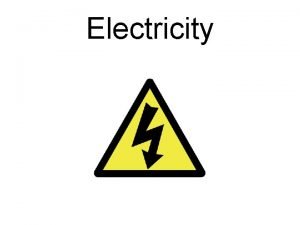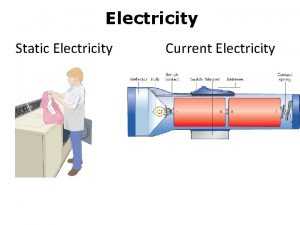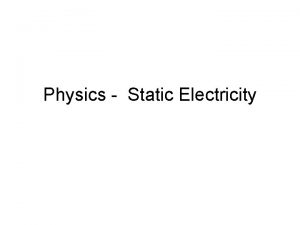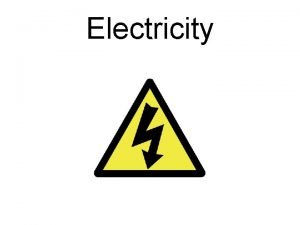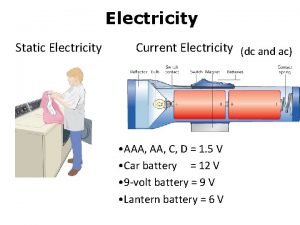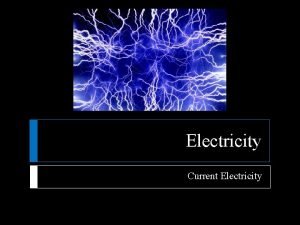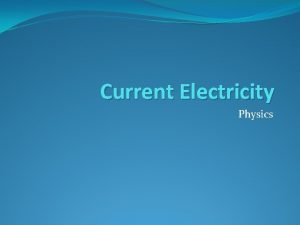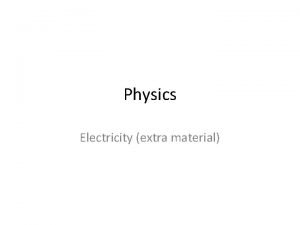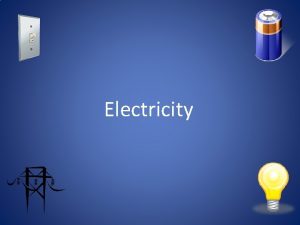National Electricity Regulator NER National Energy Regulator NERSA
















































- Slides: 48

National Electricity Regulator (NER) & National Energy Regulator (NERSA) Annual Reports 2005/2006 1

Content • • Introduction NER: – – – – • NERSA: – – – – • Structure of the Board Structure of the Secretariat Strategic Objectives Performance Against Objectives Highlights Staff Analysis Financial Performance Structure of the Energy Regulator Structure of the Secretariat Strategic Objectives Performance Against Objectives Highlights Staff Analysis Financial Performance Conclusion 2

Introduction • The National Electricity Regulator (NER) was established in 1995 to regulate the electricity industry • NER discontinued its operations on 30 September 2005 but continued regulating the electricity industry until 16 July 2006 when it ceased to exist • Therefore the NER Annual Report covers the period 1 April 2005 to 30 September 2005. The electricity regulation report continues until 31 March 2006. The period 1 April 2006 to 16 July 2006 is covered with an attached addendum 3

Introduction (Cont. ) • The National Energy Regulator (NERSA) was established on 1 October 2005 and the Regulator Members were appointed with effect from that date • NERSA took over all assets and liabilities of NER as well as all personnel and other resources on its establishment date, 1 October 2005. Therefore the NERSA Annual Report covers the period 1 October 2005 to 31 March 2006 • NERSA started regulating piped-gas and petroleum pipeline industries on 1 November 2005 and electricity industry on 17 July 2006 4

National Electricity Regulator (NER) 5

Structure of the Board • The NER Board consisted of 9 Board Members – 8 Members were part-time – 1 Member was full-time (CEO) • Board Members were appointed by the Minister of Minerals and Energy • The Board had 7 committees – Policy – Regulatory Committees: • Pricing and Tariffs • Licensing, Compliance, Complaints and Customer Services – Governance Committees: • Audit and Risk • Finance • Human Resources – Ad Hoc Committee on the establishment of NERSA 6

Structure of the Secretariat • 3 Divisions each with a number of departments – Headed by Executive Managers • 3 Specialised Support Units – Headed by Senior Managers • Executive Managers and Senior Managers report directly to CEO • Total staff complement = 115 7

Strategic Objectives • Ensuring the effective and efficient regulation of the existing electricity industry • Ensuring that the NER is appropriately prepared and able to effectively regulate the future reformed electricity industry • Promoting appropriate procurement mechanisms and regulatory frameworks for new generation capacity • Developing and retaining requisite skills and competencies within the NER • Improving and sustaining the good image of the NER 8

Strategic Objectives (Cont. ) • Enhancing the integrity of the NER by improving internal management systems and procedures • Effectively contributing to the socio-economic development programmes of government • Establishing a single energy regulator (which will incorporate gas and petroleum pipelines regulation, in addition to electricity regulation) on the foundation of the experience of the NER 9

Performance Against Objectives • Of the planned activities 57% were executed as planned • Of the 37 planned activities, 30% were on track • Key factors impacting on execution: – – ESI/EDI restructuring process Slow responses from external participants Challenges in the effective management of projects High staff turnover experienced during the year 10

Highlights • The Multi-Year Price Determination (MYPD) mechanism was approved by the Board and published for stakeholder comments followed by a well attended stakeholder workshop • The Board approved the MYPD for Eskom Price Basis 2006/07 2007/08 2008/09 Average price increase excluding EDI restructuring costs 4. 57% 5. 37% 5. 67% Average price increase including EDI restructuring costs 5. 10% 5. 90% 6. 20% 11

Highlights (Cont. ) • Licensed RED 1 before it was formally launched on 1 July 2005 • Announced the findings of an independent technical audit of City Power • Conducted independent technical audits in eleven municipalities and Eskom electricity distributors • Launched second National Integrated Resource Plan (NIRP 2) and commenced with development of NIRP 3 under the guidance and approval of the NIRP Advisory and Review Committee • Western Cape Power Outages investigation and report • Tariff review of 157 municipalities 12

Highlights (Cont. ) • Participated in a “Take a girl-child to work” programme where six girls from Khayelitsha, Mitchell’s Plain and Langa were mentored by the Board members, CEO and Executive Managers • NER Staff raised an amount of R 17 000. 00 for the Schaaphok School near Entabeni Game Farm in the Limpopo Province • Launched the National Energy Regulator (NERSA) on 22 November 2005 • Participated in and contributed to regional and continental initiatives (RERA & AFUR) 13

Staff Analysis (Race) Level Top Management African Coloured Asian White Total 3 1 4 (75%) (25%) Senior Management 10 (77%) Professional & Middle Management 30 (69%) 2 (5%) Skilled and Technical 19 (83%) 1 (4%) Semi-skilled 14 (93%) Total 76 (78%) 3 (3%) 3 (23%) 13 2 (5%) 9 (21%) 43 1 (4%) 2 (9%) 23 1 (7%) 15 15 (15%) 98 4 (4%) 14

Staff Analysis (Gender) Level Male Female Total 4 Top Management 3 (75%) 1 (25%) Senior Management 6 (46%) 7 (54%) 13 Professional and Middle Management 22 (51%) 21 (49%) 43 Skilled and Technical 12 (52%) 11 (48%) 23 Semi-skilled 4 (27%) 11 (73%) 15 47 (48%) 51 (52%) 98 Total 15

Financial Analysis • Financial Management and Accounting at the NER is governed by: – PFMA – Treasury Regulations – Generally Accepted Accounting Practices (GAAP) 16

Financial Analysis (Cont. ) • Approved expenditure budget (excluding Capex) for the period 1 April 2005 to 30 September 2005 was R 36. 2 million • Actual Expenditure for the period 1 April 2005 to 30 September 2005 was R 33. 5 million • Surplus as at the end of the financial period was R 2. 8 million 17

Financial Analysis (Cont. ) • Budget Variance Analysis Budget Actual Income (R’ 000) Levies R 34. 0 million R 35. 3 million Employee Costs R 18. 2 million R 16. 3 million Other Operating Costs R 11. 1 million R 14. 2 million Fees for Services R 6. 1 million R 2. 1 million Board Members R 0. 8 million R 0. 9 million R 36. 2 million R 33. 5 million R 1. 1 million R 3. 9 million R 37. 3 million R 37. 4 million Expenditure (R’ 000) Total Operating Expenditure Capex Total Expenditure 18

Financial Analysis (Cont. ) • Expenditure categories in relation to the total operating expenditure – Employee Costs = 49% – Fees for Services = 6% – Board Members = 3% • Capital expenditure amounts to 10% of total 19

Financial Analysis (Cont. ) • NER received an unqualified audit opinion from the Auditor-General • The audit did however raise the following emphasis of matter: – Payroll (Salary) Fraud – Transfer of operational activities to NERSA 20

Financial Analysis (Cont. ) • Operational Results: – Total assets have increased to R 54. 8 million indicating an increase of 24% from 31 March 2005 – Cash and cash equivalent of R 23 million consists of the NER’s main bank account and deposits held at the Reserve Bank in terms of Cooperation of Public Deposits (CPD) – Other operating expenditure includes rental under operating leases for office equipment, variable costs and notional depreciation charges – 12% of capital expenditure was spent on acquisition of computer hardware and accessories, 14% on computer software, (16%) on office equipment and the balance on the building – Land building is fully paid up and owned by NERSA with a carrying value of R 20. 0 million as at 30 September 2005 – The ratio for current assets to current liabilities is 6: 1 which indicates that NER was a viable entity as a going concern on 30 September 2005 when all assets and liabilities were transferred to NERSA and NER discontinued its operations 21

National Energy Regulator (NERSA) 22

Structure of the Energy Regulator • 9 Regulator Members – 5 part-time Members – 4 full-time Members • Appointed by Minister of Minerals and Energy • Chairperson & Deputy Chairperson part-time • Full-time Regulator Members: – Chief Executive Officer – 3 Regulator Members primarily responsible for each of electricity, piped-gas and petroleum pipelines regulation 23

Structure of the Energy Regulator (Cont. ) • 8 Subcommittees of the Energy Regulator: – Policy – Regulatory: • Licensing • Pricing and Tariffs • Compliance and Dispute Resolution – Governance: • • Finance Audit and Risk Human Resources Remuneration 24

Structure of the Secretariat • 4 Divisions each with a number of departments – Headed by Executive Managers • 5 Specialised Support Units – Headed by Senior Managers • Executive Managers and Senior Managers report directly to CEO • Total staff complement = 143 25

Strategic Objectives • To monitor and administer the Mozambique Gas Pipeline Agreement • To implement the Gas Act • To license existing and new activities in the pipedgas industry • To implement the Petroleum Pipelines Act • To license new and existing activities in the petroleum pipeline industry • To facilitate access to the petroleum pipeline infrastructure 26

Strategic Objectives (Cont. ) • To develop and implement appropriate pricing and tariff methodologies for the petroleum pipeline industry • To implement the National Energy Regulator Act, especially in areas of public hearings, enquiries, tribunals and resolution of disputes • Effectively contributing to the socio-economic development programmes of government • To establish and maintain a comprehensive database for the energy industry • To promote competition and BEE in the three industries • To ensure that the requirements of the industry acts on safety, environmental, health and security in the industry are complied with 27

Performance Against Objectives • NERSA Strategic Plan (2005/06 – 2007/08) and Business Plan (2005/06) was developed under the assumption that NERSA would be established on 1 April 2005 • This only took place on 1 October 2005 • Gas Act, 2001 (Act No. 48 of 2001), Petroleum Pipelines Act, 2003 (Act No. 60 of 2003), Gas Regulator Levies Act, 2002 (Act No. 75 of 2002) & Petroleum Pipeline Levies Act, 2004 (Act No. 28 of 2004) came into operation on 1 November 2005 • Activities relating to the regulation of the piped-gas and petroleum pipeline industries only started on 1 November 2005 (7 months later than planned for in the Business Plan) • Therefore it was expected that all projects relating to the regulation of piped-gas and petroleum pipelines will not be concluded as planned • Of the 35 planned projects – work on only 7 (20%) commenced • 28 projects that were not started did not form part of the basis of 28 reporting

Performance Against Objectives (Cont. ) • 84% of activities executed as planned • Of the 56 planned activities – 73% on track • Key factors impacting on execution: – Start-up momentum associated with a new Energy Regulator, especially regulating piped-gas and petroleum pipelines industries for the first time – High staff turnover – Number of secondments due to the establishment of NERSA 29

Highlights - Regulatory • Inaugural meeting of the Energy Regulator on 9 November 2005 • Gas Act Rules Part One: Licensing 2006 were approved by the Energy Regulator and promulgated • Petroleum Pipelines Act Rules Part One: Licensing 2006 were approved by the Energy Regulator and promulgated • Energy Regulator submitted comments on the draft Piped-Gas and Petroleum Pipeline Regulations to the Minister of Minerals and Energy 30

Highlights - Governance • Members of the Energy Regulator appointed with effect from 1 October 2005 • As required by the National Energy Regulator Act, 2004 (Act No. 40 of 2004), all staff in the employment of the NER on 30 September 2005, were transferred to the employment of NERSA with effect from 1 October 2005 • NER assets and liabilities transferred to NERSA on 1 October 2005 31

Highlights – Governance (Cont. ) • Ring-fencing methodology was implemented as part of National Energy Regulator Act requirement for financial reporting structure • The proposed piped-gas and petroleum pipeline levies were gazetted in November 2005 and representation received, analysed and taken into account in revising the 2006/07 budget • Revised Strategic Plan (2006/07 – 2008/09) and Business Plan with Budget (2006/07) was submitted to the Minister of Minerals and Energy for approval • Participated in and contributed to regional and continental initiatives (RERA & AFUR) 32

Staff Analysis - Race Level African Coloured Asian White Top Management 4 (80%) Senior Management 15 (75%) 1 (5%) Professional & Middle Management 27 (69%) 3 (8%) Skilled and Technical 17 (85%) 1 (5%) Semi-skilled 17 (89%) Total 80 (78%) 1 (20%) 5 (5%) 1 (3%) 2 (2%) Total 5 4 (20%) 20 8 (20%) 39 2 (10%) 20 2 (11%) 19 16 (15%) 103 33

Staff Analysis - Gender Level Male Female Total Top Management 4 (80%) 1 (20%) 5 Senior Management 10 (50%) 20 Professional and Middle Management 20 (51%) 19 (49%) 39 Skilled and Technical 10 (50%) 20 Semi-skilled 3 (16%) 16 (84%) 19 47 (46%) 56 (54%) 103 Total 34

Financial Performance • Financial Management NERSA is governed by: and Accounting at – PFMA – Treasury Regulations – Generally Accepted Accounting Practices (GAAP) 35

Financial Performance (Cont. ) • Approved expenditure budget (excluding Capex) for the period 1 October 2005 to 31 March 2006 was R 53. 5 million • Actual Expenditure for the period 1 October 2005 to 31 March 2006 was R 49. 3 million • Deficit as at the end of the financial year was R 15. 6 million 36

Financial Performance (Cont. ) • Ring-fencing methodology – According to Section 13 of the National Energy Regulator Act – All direct costs – allocated directly to the three regulated industries – The common costs will be apportioned based on the direct employment costs for each industry – All common costs will thus be allocated on the following ratio: • 60% electricity industry • 20% piped-gas industry • 20% petroleum pipeline industry 37

Financial Performance (Cont. ) • Budget Variance Analysis (Combined) Budget Actual Income (R’ 000) Levies R 56. 2 million R 31. 0 million Employee Costs R 24. 5 million R 16. 9 million Other Operating Costs R 20. 6 million R 23. 7 million Fees for Services R 6. 9 million R 6. 5 million Regulator Members R 1. 5 million R 2. 2 million R 53. 5 million R 49. 3 million R 5. 9 million R 2. 6 million R 59. 4 million R 51. 9 million Expenditure (R’ 000) Total Operating Expenditure Capex Total Expenditure 38

Financial Performance (Cont. ) • Budget Variance Analysis (Electricity Industry) Budget Actual Income (R’ 000) Levies R 34. 0 million R 31. 0 million Other Income R 0. 8 million R 1. 3 million R 36. 2 million R 36. 0 million - R 3. 3 million Expenditure (R’ 000) Operating Expenditure Deficit from Operations 39

Financial Performance (Cont. ) • Budget Variance Analysis (Piped-gas Industry) Budget Actual Income (R’ 000) Levies Other Income R 11. 1 million - - R 0. 5 million R 8. 7 million R 6. 7 million - R 6. 2 million Expenditure (R’ 000) Operating Expenditure Deficit from Operations 40

Financial Performance (Cont. ) • Budget Variance Analysis (Petroleum Pipeline Industry) Budget Actual Income (R’ 000) Levies Other Income R 11. 1 million - - R 0. 5 million R 8. 7 million R 6. 6 million - R 6. 1 million Expenditure (R’ 000) Operating Expenditure Deficit from Operations 41

Financial Performance (Cont. ) • Expenditure categories in relation to total operating expenditure – Employee Costs = 34% – Fees for Services = 13% – Regulator Members = 4% • Capital expenditure amounted to 5% of total expenditure 42

Financial Performance (Cont. ) • NERSA received an unqualified audit opinion from the Auditor-General • The audit did however raise the following emphasis of matter: – Payroll (Salary) Fraud – Establishment of NERSA • Implementation of audit findings are being addressed and monitored by the Operational Risk Committee at staff level and reported on to the Audit and Risk Subcommittee of the Energy 43 Regulator to ensure compliance

Financial Performance (Cont. ) • Operational Results: – Net deficit for NERSA for the year ended 31 March 2006 was R 15. 6 million – R 30. 9 million was collected as levies from the electricity industry for the period 1 October 2005 to 31 March 2006. No levies were received from the piped-gas and petroleum pipeline industries – Expenditure incurred of R 49. 3 million was within the approved budget – Fees for Services included Auditor General Remuneration and technical consultancy costs for projects – More than 50% of NERSA purchases are made through BEE companies 44

Financial Performance (Cont. ) • Operational Results (Cont. ): – Total assets have increased to R 47. 8 million indicating an increase of 8. 4% from 31 March 2005 – The ratio for current assets to current liabilities is 1. 6: 1 which indicates that NERSA is a viable entity as a going concern – Cash and cash equivalent of R 21 million consists of NERSA’s main bank account and deposits held at the Reserve Bank in terms of Co-operation of Public Deposits (CPD) 45

Financial Performance (Cont. ) • Operational Results (Cont. ): – Other operating expenditure includes rental under operating leases for office equipment, variable costs and notional depreciation charges – 40% of capital expenditure was spent on acquisition of computer hardware and accessories, 29% on office equipment, (8%) on computer software and licenses and the balance on the building – Land building is fully paid up and owned by NERSA with a carrying value of R 20. 6 million as at 31 March 2006 46

Conclusion • NER formed a good basis for NERSA establishment • Electricity regulation existed since 1995 whilst hydrocarbons regulation is at its infancy (2005); licensing in particular is a challenge • On the date of transfer of the assets and liabilities NER was a viable entity as a going concern • Transition from NER to NERSA is being managed • Cash-flow mitigating strategies and (piped-gas and petroleum pipelines) levies collection mechanism are being developed, formalised and implemented • Staff recruitment, development, motivation and retention remain a challenge 47

Thank You 48
 Static electricity and current electricity
Static electricity and current electricity Current electricity gif
Current electricity gif How are static electricity and current electricity alike
How are static electricity and current electricity alike Adjusted net enrolment ratio
Adjusted net enrolment ratio Ned ner
Ned ner Ner
Ner Stanford ner
Stanford ner Dr ner
Dr ner Turk ner
Turk ner Key information extraction
Key information extraction Adli bilimler nedir
Adli bilimler nedir Krister bauer
Krister bauer Accu spot price
Accu spot price What is energy made of
What is energy made of Learning outcomes generator
Learning outcomes generator Electricity form
Electricity form Formula energy
Formula energy Energy formula
Energy formula Energy energy transfer and general energy analysis
Energy energy transfer and general energy analysis Energy energy transfer and general energy analysis
Energy energy transfer and general energy analysis Transistor series voltage regulator design
Transistor series voltage regulator design Recloser bypass switch
Recloser bypass switch Układ regulacji dwupołożeniowej
Układ regulacji dwupołożeniowej Altivar 31
Altivar 31 Pneumatic regulator symbol
Pneumatic regulator symbol The maximum safe working pressure for acetylene is
The maximum safe working pressure for acetylene is Power conditioning voltage regulator with front access
Power conditioning voltage regulator with front access Hydraulic schematic symbols
Hydraulic schematic symbols Regulator moderator war
Regulator moderator war Feedback matrix examples
Feedback matrix examples Op amp voltage regulator
Op amp voltage regulator Types of regulator
Types of regulator Regulacja trójpołożeniowa
Regulacja trójpołożeniowa Reostat schematická značka
Reostat schematická značka Regulator neutral detector
Regulator neutral detector Recloser bypass switch
Recloser bypass switch Pirouette growth regulator
Pirouette growth regulator Example of middle range theory
Example of middle range theory Simbol air service
Simbol air service Linear quadratic regulator example
Linear quadratic regulator example Gas shielded arc welding
Gas shielded arc welding Regulator adalah
Regulator adalah Regulator proporcjonalno-całkująco-różniczkujący
Regulator proporcjonalno-całkująco-różniczkujący In a voltage regulator network with fixed rl and r
In a voltage regulator network with fixed rl and r Frc pdp
Frc pdp Ic 723 pin diagram
Ic 723 pin diagram Regulator economics definition
Regulator economics definition Electromechanical voltage regulator
Electromechanical voltage regulator Acetylene is unstable at pressures above ____ psig.
Acetylene is unstable at pressures above ____ psig.





